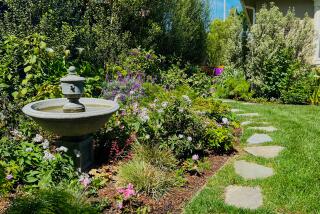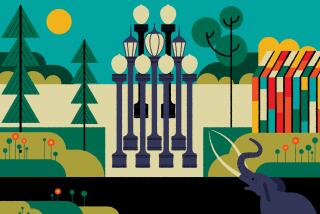Harvesting The Past : The Tools, Values That Shaped America in Place at Antique Gas, Steam Engine Museum in Vista
- Share via
At 86, Lambert Ninteman is a former Minnesota farm boy who admits that you can take the boy off the farm but that you can never take the farm out of the boy. He left the family farm at 12 and went on to other adventures.
But he never forgot his roots in America’s heartland or the equipment used to till the soil and harvest its bounty.
Karen Harmon, 34, of Lakewood, is an elementary school librarian and an avowed city girl. Yet she too finds something special in the work and values borne of the American farm. She feels it’s important to show children what farm life was like in the early 1900s, “because it’s history that’s there and will be lost forever if it’s not passed on.”
Ninteman and Harmon share their passion for early farm life at the Antique Gas and Steam Engine Museum in Vista, just east of Oceanside.
On the surface, the museum complex is a collection of antique farm equipment but, because of people like Ninteman and Harmon, it is much more.
“The museum is not only collecting and preserving artifacts and demonstrating a way of life of days gone by,” says Heather Johnson, director of museum programs, “it still operates with the values and principles that enabled America to become what it is today.”
The complex, located on 40 hilly acres, has a working farm--20 acres of wheat, which volunteers plant, harvest, thresh, grind into flour and bake into bread and pies--and a farmhouse with a country kitchen and parlor, a blacksmith shop, a wheelwright shop and a 1900-era sawmill.
Museum Demonstrations
In some ways, the Threshing Bee and Antique Engine Show today, Sunday and next weekend is what the museum is really about. An estimated 20,000 people are expected to attend the event, which includes a parade of operational antique gas and steam equipment; demonstrations of the sawmill and the wheelwright; blacksmith shops, and rides on a one-third-scale train. It also includes square dancing, hayrides, a fair focusing on Early American crafts, bluegrass music and an 1898 steam fire engine.
“Sharing, both the work and the harvest, was a way of life for the farmers,” Johnson says. “Farm families joined together to help one another with large, time-consuming tasks--threshing bees, barn raisings, quilting bees.”
The philosophy “many hands make light work” can still be observed at the museum, Johnson says, thus the name Threshing Bee for its major fund-raiser and educational/recreational offering to the community.
The show will feature fresh apple cider from an antique cider press, along with home-baked goodies, fresh apple pie baked in the farmhouse, an old-fashioned barbecue and demonstrations of planting, harvesting and threshing.
In addition, visitors can stroll the grounds and marvel at the equipment on display.
About 1,200 people belong to the California Early Days Gas Engine and Tractor Assn., launched in 1969 in Guajome County Park.
“It started out with the tractor club, those who collect tractors and restore them,” says Ninteman, now retired from L. J. Ninteman Construction Co. of Escondido.
‘A Good Time’
Ninteman says he is “having a heck of a good time” as chairman of the museum board. He helped launch the museum by donating his extensive collection of early farm equipment. Even he is not sure exactly how many pieces he has donated over the years, because his collection is “spread all over the premises,” part of more than 1,000 large pieces owned by the museum.
Some of the pieces were found on old farms, like a small engine that Ninteman found “in some junk” that is worth $3,000 restored. Other equipment has been donated or is on loan from collectors, many of whom have spent thousands of dollars on restoration.
One of Ninteman’s favorites from his collection is a fully restored, gray 1912 Fordson tractor, designed by Henry Ford. Ninteman says the faint inscription that shows the tractor was built in “The Irish Free State,” explaining how Ford built tractors in Europe for a time to avoid patent problems.
It may be hard to think of a tractor as beautiful, but think again.
The Fordson stands proudly in a stately lineup of more than two dozen tractors that have been painstakingly restored with thousands of hours of hard work. They sit gleaming in the sun with shiny new red, bright-yellow, green or black paint jobs, as if in formation and ready to glide out across the fields.
Behind these tractors, there is a second tier of equipment that clearly has seen better days. Rusty and unused, these pieces patiently await restoration.
The museum, which is near the colorful lineup of tractors, is crammed with antique equipment, most of which is in running condition. A fully restored forest-green, 1939 John Deere tractor, which originally cost $795, may be worth upward of $20,000, according to Ninteman. Nearby is a classic 1903 Oldsmobile horseless carriage with black leather upholstery.
Bean Thresher
Down another aisle is the Keystone No. 3, a turn-of-the-century bean thresher used to remove hulls from dried beans. A 1902, 15-horsepower gasoline engine, once used to pull in fishing nets, required 2,000 hours of restoration.
And there is a wooden treadmill, evidence of the true ingeniousness of early farmers. A goat, or some other small animal, would be placed on the treadmill, “fueled” by bits of food in a small box on front of the machine. As the goat walked and ate, the wooden treadmill moved, generating power to pump water, turn a butter churn or for some other task.
Near the museum building, a shed houses huge farm machines, including a towering 1912 Case steam tractor, with metal wheels measuring 6 feet in diameter. Restored to full working capacity, the tractor now is used to run the sawmill.
Harmon and her husband, Allan, have sometimes spent as many as 60 hours a month volunteering at the museum.
“It’s our home away from home,” she says. The Harmons and son Russell, 12, spend several weekends each month in the farming area, doing ground maintenance, paper work or other necessary tasks.
During the Threshing Bee, Harmon works in the gift shop, while the rest of the family helps with the hayrides or threshing. She also serves on the museum board as director of education and coordinates the school tour program.
Antique Tractor
It’s not all work, however. It can be fun too. Harmon has discovered the joys of operating an antique tractor.
“I really enjoy going out and driving a tractor,” she says. “I find it very humbling not to do anything, just to go up and around the field . . . just a very slow pace. It’s my way to get back to my roots.”
The Antique Gas and Steam Museum is open daily from 10 a.m. to 4 p.m. and conducts tours for schoolchildren four times a year. The Threshing Bee and Antique Engine Show is $3 donation for adults; children 15 and younger free.
Antique Gas and Steam Engine Museum, Guajome County Park, 2040 N. Santa Fe Ave . , Vista. Take Interstate 5 to Oceanside Boulevard, go east about 7 miles. Today, Sunday and next Saturday and Sunday, 9 a.m.-4:30 p.m. Information: (619) 941-1791, Tuesday-Friday.
More to Read
Sign up for The Wild
We’ll help you find the best places to hike, bike and run, as well as the perfect silent spots for meditation and yoga.
You may occasionally receive promotional content from the Los Angeles Times.






